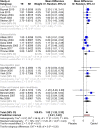Does opioid therapy enhance quality of life in patients suffering from chronic non-malignant pain? A systematic review and meta-analysis
- PMID: 38751560
- PMCID: PMC11092930
- DOI: 10.1177/20494637231216352
Does opioid therapy enhance quality of life in patients suffering from chronic non-malignant pain? A systematic review and meta-analysis
Abstract
Background and objective: Chronic pain is associated with a poor health-related quality of life (HRQL). Whereas the prescription rate of opioids increased during the last decades, their use in chronic non-malignant pain remains unclear. However, there is currently no clinical consensus or evidence-based guidelines that consider the long-term effects of opioid therapy on HRQL in patients with chronic non-cancer pain. This systematic review aims to address the question of whether opioid therapy improves HRQL in patients with chronic non-malignant pain and provide some guidance to practitioners.
Databases and data treatment: PubMed, EMBASE and CENTRAL were searched in June 2020 for double-blind, randomized trials (RCTs), comparing opioid therapy to placebo and assessed a HRQL questionnaire. The review comprises a qualitative vote counting approach and a meta-analysis of the Short Form Health Survey (SF-36), EQ-5D questionnaire and the pain interference scale of the Brief pain inventory (BPI).
Results: 35 RCTs were included, of which the majority reported a positive effect of opioids for the EQ-5D, the BPI and the physical component score (PCS) of the SF-36 compared to placebo. The meta-analysis of the PCS showed a mean difference of 1.82 [confidence interval: 1.32, 2.32], the meta-analysis of the EQ-5D proved a significant advantage of 0.06 [0.00, 0.12]. In the qualitative analysis of the mental component score (MCS) of the SF-36, no positive or negative trend was seen. No significant differences were seen in the MCS (MD: 0.65 [-0.43, 1.73]). A slightly higher premature dropout rate was found in the opioid group (risk difference: 0.04 [0.00, 0.07], p = .07). The body of evidence is graded as low to medium.
Conclusion: Opioids have a statistically significant, but small and clinical not relevant effect on the physical dimensions of HRQL, whereas there is no effect on mental dimensions of HRQL in patients with chronic non-malignant pain during the initial months of treatment. In clinical practice, opioid prescriptions for chronic non-cancer pain should be individually assessed as their broad efficacy in improving quality of life is not confirmed. The duration of opioid treatment should be determined carefully, as this review primarily focuses on the initial months of therapy.
Keywords: Chronic pain; health related quality of life; opioid; quality of life.
© The Author(s) 2023.
Conflict of interest statement
The author(s) declared no potential conflicts of interest with respect to the research, authorship, and/or publication of this article.
Figures








Similar articles
-
Responsible, Safe, and Effective Prescription of Opioids for Chronic Non-Cancer Pain: American Society of Interventional Pain Physicians (ASIPP) Guidelines.Pain Physician. 2017 Feb;20(2S):S3-S92. Pain Physician. 2017. PMID: 28226332
-
Opioids for Chronic Noncancer Pain: A Systematic Review and Meta-analysis.JAMA. 2018 Dec 18;320(23):2448-2460. doi: 10.1001/jama.2018.18472. JAMA. 2018. PMID: 30561481 Free PMC article.
-
Patient-reported health-related quality of life, work productivity, and activity impairment during treatment with ALO-02 (extended-release oxycodone and sequestered naltrexone) for moderate-to-severe chronic low back pain.Health Qual Life Outcomes. 2017 Oct 17;15(1):202. doi: 10.1186/s12955-017-0749-y. Health Qual Life Outcomes. 2017. PMID: 29041942 Free PMC article. Clinical Trial.
-
Therapeutic ultrasound for chronic low back pain.Cochrane Database Syst Rev. 2020 Jul 5;7(7):CD009169. doi: 10.1002/14651858.CD009169.pub3. Cochrane Database Syst Rev. 2020. PMID: 32623724 Free PMC article.
-
Chronic non-cancer pain and the long-term efficacy and safety of opioids: Some blind men and an elephant?Scand J Pain. 2012 Jan 1;3(1):5-13. doi: 10.1016/j.sjpain.2011.11.001. Scand J Pain. 2012. PMID: 29913768
Cited by
-
A qualitative interview study exploring the experiences of pain specialists on prescribing opioids for chronic non-cancer pain.Sci Rep. 2025 Aug 13;15(1):29672. doi: 10.1038/s41598-025-15113-6. Sci Rep. 2025. PMID: 40804328 Free PMC article.
References
-
- Ospina M, Harstall C. Prevalence of chronic pain. An overview. Edmonton, Alta: Alberta Heritage Foundation for Medical Research, 2002. (HTA, 29).
LinkOut - more resources
Full Text Sources
